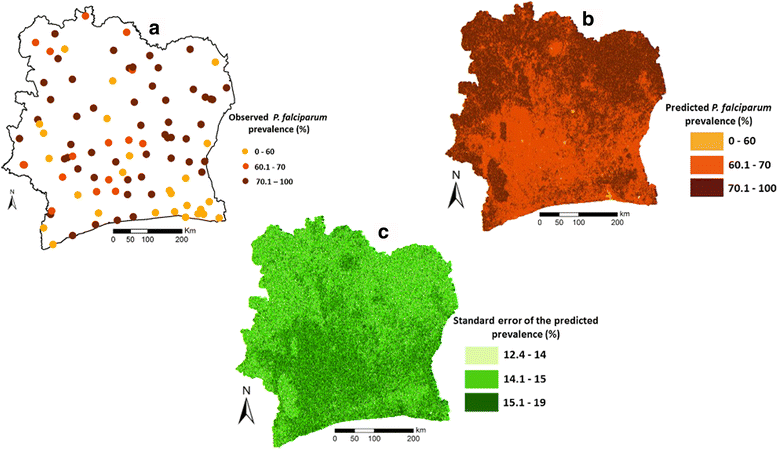Spatial mapping and prediction of Plasmodium falciparum infection risk among school-aged children in Côte d'Ivoire
- PMID: 27604807
- PMCID: PMC5015250
- DOI: 10.1186/s13071-016-1775-z
Spatial mapping and prediction of Plasmodium falciparum infection risk among school-aged children in Côte d'Ivoire
Abstract
Background: In Côte d'Ivoire, malaria remains a major public health issue, and thus a priority to be tackled. The aim of this study was to identify spatially explicit indicators of Plasmodium falciparum infection among school-aged children and to undertake a model-based spatial prediction of P. falciparum infection risk using environmental predictors.
Methods: A cross-sectional survey was conducted, including parasitological examinations and interviews with more than 5,000 children from 93 schools across Côte d'Ivoire. A finger-prick blood sample was obtained from each child to determine Plasmodium species-specific infection and parasitaemia using Giemsa-stained thick and thin blood films. Household socioeconomic status was assessed through asset ownership and household characteristics. Children were interviewed for preventive measures against malaria. Environmental data were gathered from satellite images and digitized maps. A Bayesian geostatistical stochastic search variable selection procedure was employed to identify factors related to P. falciparum infection risk. Bayesian geostatistical logistic regression models were used to map the spatial distribution of P. falciparum infection and to predict the infection prevalence at non-sampled locations via Bayesian kriging.
Results: Complete data sets were available from 5,322 children aged 5-16 years across Côte d'Ivoire. P. falciparum was the predominant species (94.5 %). The Bayesian geostatistical variable selection procedure identified land cover and socioeconomic status as important predictors for infection risk with P. falciparum. Model-based prediction identified high P. falciparum infection risk in the north, central-east, south-east, west and south-west of Côte d'Ivoire. Low-risk areas were found in the south-eastern area close to Abidjan and the south-central and west-central part of the country.
Conclusions: The P. falciparum infection risk and related uncertainty estimates for school-aged children in Côte d'Ivoire represent the most up-to-date malaria risk maps. These tools can be used for spatial targeting of malaria control interventions.
Keywords: Bayesian modelling; Côte d’Ivoire; Malaria; Plasmodium falciparum; School-aged children.
Figures

Similar articles
-
Disparities of Plasmodium falciparum infection, malaria-related morbidity and access to malaria prevention and treatment among school-aged children: a national cross-sectional survey in Côte d'Ivoire.Malar J. 2015 Jan 5;14:7. doi: 10.1186/1475-2875-14-7. Malar J. 2015. PMID: 25559587 Free PMC article.
-
Spatial risk profiling of Plasmodium falciparum parasitaemia in a high endemicity area in Côte d'Ivoire.Malar J. 2009 Nov 11;8:252. doi: 10.1186/1475-2875-8-252. Malar J. 2009. PMID: 19906295 Free PMC article.
-
Mapping malaria risk among children in Côte d'Ivoire using Bayesian geo-statistical models.Malar J. 2012 May 9;11:160. doi: 10.1186/1475-2875-11-160. Malar J. 2012. PMID: 22571469 Free PMC article.
-
A scoping review of literature describing the nutritional status and diets of adolescents in Côte d'Ivoire.Public Health Nutr. 2021 Nov;24(16):5261-5276. doi: 10.1017/S1368980020002621. Epub 2020 Sep 4. Public Health Nutr. 2021. PMID: 32883396 Free PMC article.
-
The use of schools for malaria surveillance and programme evaluation in Africa.Malar J. 2009 Oct 19;8:231. doi: 10.1186/1475-2875-8-231. Malar J. 2009. PMID: 19840372 Free PMC article. Review.
Cited by
-
Plasmodium falciparum parasite prevalence in East Africa: Updating data for malaria stratification.PLOS Glob Public Health. 2021 Dec 7;1(12):e0000014. doi: 10.1371/journal.pgph.0000014. PLOS Glob Public Health. 2021. PMID: 35211700 Free PMC article.
-
Bayesian spatial modelling of malaria burden in two contrasted eco-epidemiological facies in Benin (West Africa): call for localized interventions.BMC Public Health. 2022 Sep 16;22(1):1754. doi: 10.1186/s12889-022-14032-9. BMC Public Health. 2022. PMID: 36114483 Free PMC article.
-
The relationship between facility-based malaria test positivity rate and community-based parasite prevalence.PLoS One. 2020 Oct 7;15(10):e0240058. doi: 10.1371/journal.pone.0240058. eCollection 2020. PLoS One. 2020. PMID: 33027313 Free PMC article.
-
How useful are malaria risk maps at the country level? Perceptions of decision-makers in Kenya, Malawi and the Democratic Republic of Congo.Malar J. 2020 Oct 2;19(1):353. doi: 10.1186/s12936-020-03425-z. Malar J. 2020. PMID: 33008465 Free PMC article.
-
Factors associated with malaria infection among children after distribution of PBO-pyrethroid synergist-treated nets and indoor residual spraying in north-western Tanzania.PLoS One. 2023 Dec 21;18(12):e0295800. doi: 10.1371/journal.pone.0295800. eCollection 2023. PLoS One. 2023. PMID: 38127909 Free PMC article. Clinical Trial.
References
-
- WHO . World Malaria Report. Geneva: World Health Organization; 2015.
-
- Vos T, Barber RM, Bell B, Bertozzi-Villa A, Biryukov S, Bolliger I, Charlson F, Davis A, Degenhardt L, Dicker D, Duan L, Erskine H, Feigin VL, Ferrari AJ, Fitzmaurice C, Fleming T, Graetz N, Guinovart C, Haagsma J, Hansen GM, Hanson SW, Heuton KR, Higashi H, Kassebaum N, Kyu H, Laurie E, Liang X, Lofgren K, Lozano R, MacIntyre MF, et al. Global, regional, and national incidence, prevalence, and years lived with disability for 301 acute and chronic diseases and injuries in 188 countries, 1990–2013: a systematic analysis for the Global Burden of Disease study 2013. Lancet. 2015;386:743–800. doi: 10.1016/S0140-6736(15)60692-4. - DOI - PMC - PubMed
Publication types
MeSH terms
LinkOut - more resources
Full Text Sources
Other Literature Sources

